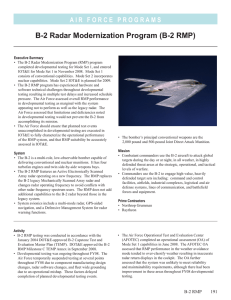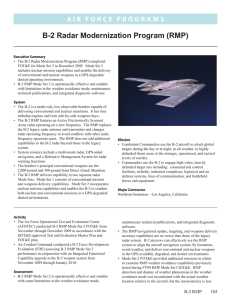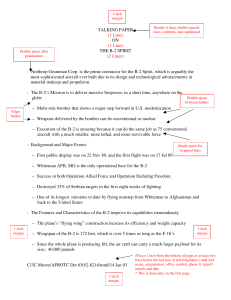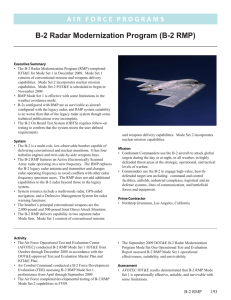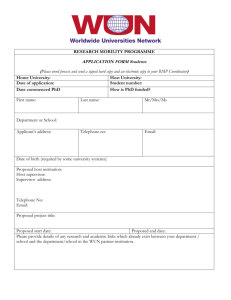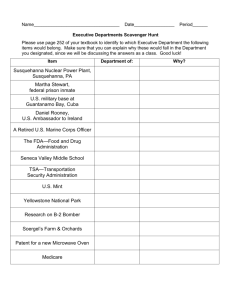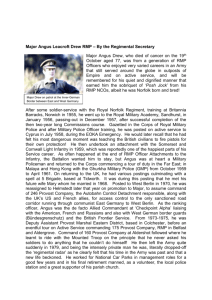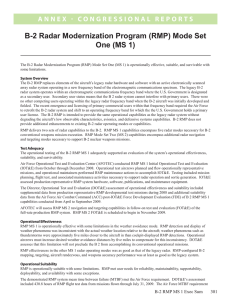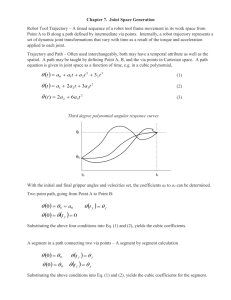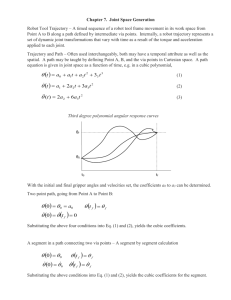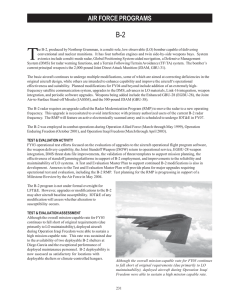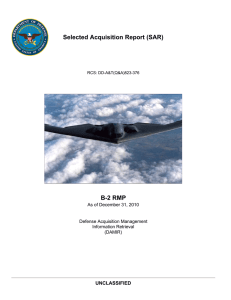B-2 Radar Modernization Program (B-2 RMP)
advertisement
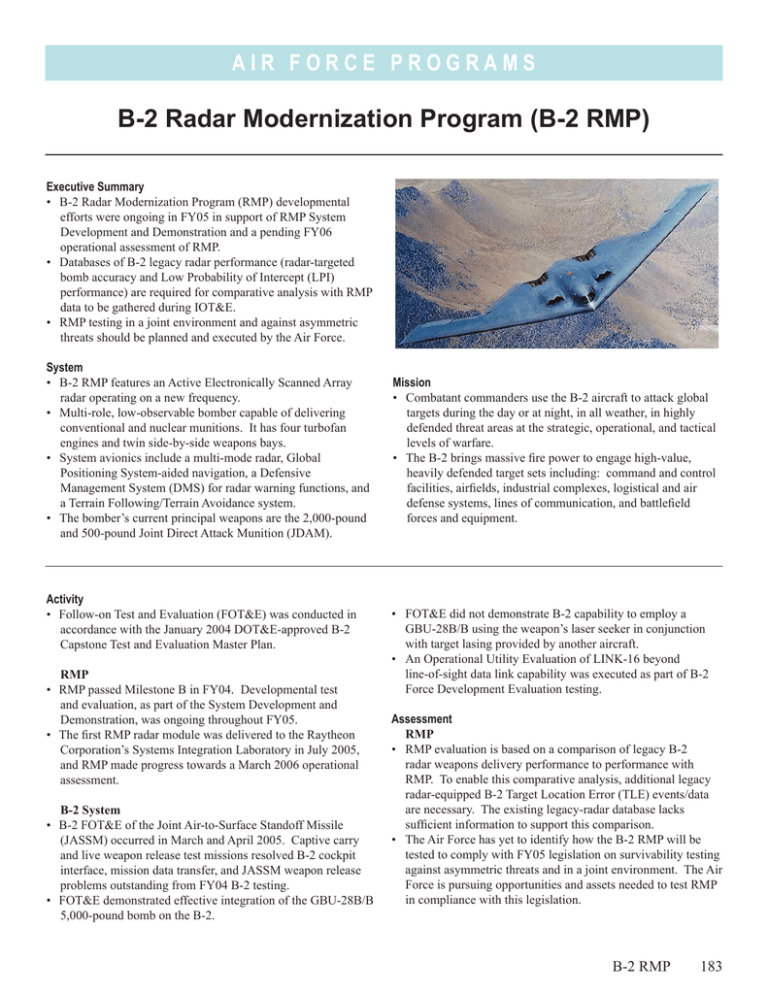
AIR FORCE PROGRAMS B-2 Radar Modernization Program (B-2 RMP) Executive Summary • B-2 Radar Modernization Program (RMP) developmental efforts were ongoing in FY05 in support of RMP System Development and Demonstration and a pending FY06 operational assessment of RMP. • Databases of B-2 legacy radar performance (radar-targeted bomb accuracy and Low Probability of Intercept (LPI) performance) are required for comparative analysis with RMP data to be gathered during IOT&E. • RMP testing in a joint environment and against asymmetric threats should be planned and executed by the Air Force. System • B-2 RMP features an Active Electronically Scanned Array radar operating on a new frequency. • Multi-role, low-observable bomber capable of delivering conventional and nuclear munitions. It has four turbofan engines and twin side-by-side weapons bays. • System avionics include a multi-mode radar, Global Positioning System-aided navigation, a Defensive Management System (DMS) for radar warning functions, and a Terrain Following/Terrain Avoidance system. • The bomber’s current principal weapons are the 2,000-pound and 500-pound Joint Direct Attack Munition (JDAM). Activity • Follow-on Test and Evaluation (FOT&E) was conducted in accordance with the January 2004 DOT&E-approved B-2 Capstone Test and Evaluation Master Plan. RMP • RMP passed Milestone B in FY04. Developmental test and evaluation, as part of the System Development and Demonstration, was ongoing throughout FY05. • The first RMP radar module was delivered to the Raytheon Corporation’s Systems Integration Laboratory in July 2005, and RMP made progress towards a March 2006 operational assessment. B-2 System • B-2 FOT&E of the Joint Air-to-Surface Standoff Missile (JASSM) occurred in March and April 2005. Captive carry and live weapon release test missions resolved B-2 cockpit interface, mission data transfer, and JASSM weapon release problems outstanding from FY04 B-2 testing. • FOT&E demonstrated effective integration of the GBU-28B/B 5,000-pound bomb on the B-2. Mission • Combatant commanders use the B-2 aircraft to attack global targets during the day or at night, in all weather, in highly defended threat areas at the strategic, operational, and tactical levels of warfare. • The B-2 brings massive fire power to engage high-value, heavily defended target sets including: command and control facilities, airfields, industrial complexes, logistical and air defense systems, lines of communication, and battlefield forces and equipment. • FOT&E did not demonstrate B-2 capability to employ a GBU-28B/B using the weapon’s laser seeker in conjunction with target lasing provided by another aircraft. • An Operational Utility Evaluation of LINK-16 beyond line-of-sight data link capability was executed as part of B-2 Force Development Evaluation testing. Assessment RMP • RMP evaluation is based on a comparison of legacy B-2 radar weapons delivery performance to performance with RMP. To enable this comparative analysis, additional legacy radar-equipped B-2 Target Location Error (TLE) events/data are necessary. The existing legacy-radar database lacks sufficient information to support this comparison. • The Air Force has yet to identify how the B-2 RMP will be tested to comply with FY05 legislation on survivability testing against asymmetric threats and in a joint environment. The Air Force is pursuing opportunities and assets needed to test RMP in compliance with this legislation. B-2 RMP 183 AIR FORCE PROGRAMS • In order to compare B-2 RMP LPI performance to legacy B-2 radar LPI capability, legacy radar LPI flight testing is required. Existing legacy radar LPI data is insufficient to provide a basis for comparison to RMP LPI performance. The Air Force is refining test planning efforts to capture additional legacy radar LPI data. • B-2 DMS threat system updates are provided through updates to the DMS Mission Region Sets. Outdated laboratory software and equipment, coupled with multiple co-existing B-2 aircraft operational flight program software configurations in the field, adversely impacted the Air Force ability to produce and validate Mission Region Sets software to meet operational needs. IOT&E requires updated DMS data to ensure RMP survivability testing is accomplished with the most current operational threat data. B-2 System • FOT&E verified corrections to problems with JASSM cockpit interface, mission data transfer, and weapon release problems. • In FYO6, FOT&E will assess: - GBU-28B/B employment using target lasing from another aircraft 184 B-2 RMP - Link-16 beyond line-of-sight capability in a stressed data link network environment Recommendations The Air Force should: RMP 1. Develop a database of TLE measurements from legacy radar delivered weapons to allow a comparison with similar TLE measurements to be made with the RMP radar system during IOT&E. 2. Identify a test regimen prior to Milestone C to confirm any B-2 vulnerability to an asymmetric threat when utilizing the modernized radar. Ensure a joint test and evaluation venue for B-2 RMP testing. 3. Conduct additional low probability of intercept flight testing with the B-2 legacy system to quantify B-2 LPI legacy system performance for comparison to RMP capabilities. B-2 System 1. Update Defense Management System Mission Region Set data before conducting RMP IOT&E.
